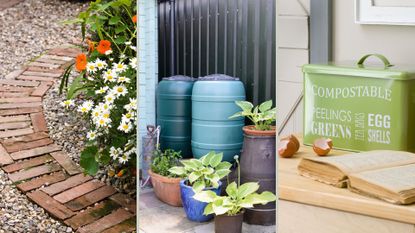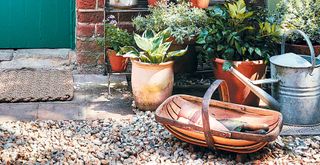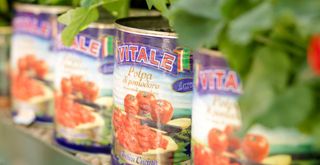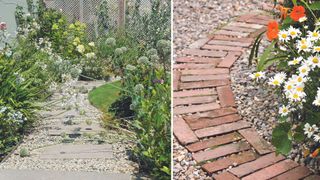14 easy sustainable garden ideas recommended by horticultural experts
Adopt these expert-approved methods of tending to your plot to create a more sustainable garden


Sustainable garden ideas are a thoughtful way to save resources and make a contribution to the well-being of our ecosystem while tending to our plots.
As the one resounding element running through all of the major garden trends for 2024 sustainability now plays an integral role in our day-to-day lives at home. From more sustainable living habits around the house to the way we reserve and preserve to make a difference while tending to our gardens.
We've spoken to leading experts in the world of gardening to source their top tips for sustainable gardening. From preserving water to using raw materials for hard landscaping, here's how we can do more to be sustainable in the garden.
14 easy sustainable garden ideas suggested by experts
Sustainable gardening is more than merely an on-trend way of managing our green spaces, it’s an ethos. With climate change becoming ever evident how we garden requires an approach that respects the balance of nature and seeks to lessen our impact on the environment.
"Everyone involved with the natural world must have climate change and sustainability at the heart of everything they do," says Libby Russell, director of Mazzullo + Russell Landscape Design.
"We are working hard to recycle and upcycle as many site materials as possible, soil engineer and protect existing soils and above all work with the site to plant plants that will tolerate extremes but always conscious that every site is very different."
Our gardens and lawns have the potential to be personal spaces of biodiversity, contributing positively to the local ecosystem rather than just being energy-consuming entities.
Sign up for the woman&home newsletter
Sign up to our free daily email for the latest royal and entertainment news, interesting opinion, expert advice on styling and beauty trends, and no-nonsense guides to the health and wellness questions you want answered.
“There are many ways that we can all ensure we are being considerate of the environment whilst also maintaining the beauty, colour, and joy of our outside havens," says gardening expert and author Sarah Raven.
"Acting thoughtfully, adopting sustainable methodology, and preserving our wonderful natural resources can be a truly rewarding experience and doesn’t require enormous effort."
How we choose to treat our surrounding environment matters because we all have a part to play. Here are the easiest ways we practice more sustainable gardening measures...

Since the publication of her first book, ‘The Cutting Garden,’ Sarah has led the way in introducing a new kind of productive gardening. Her aim, is to create intense colour and beauty, combined with a practical and easy-to-achieve approach.
Sarah’s love of gardening extends to all areas, from growing cut flowers and delicious vegetables from seed, to designing stunning gardens packed full of variety, colour, and scent. Always with a focus on helping the environment and biodiversity, Sarah’s gardens are havens for birds, bees, and other pollinators.
1. Make your own compost

Composting is one of the most commonly implemented sustainability practices for gardening, not only is it better for your soil but it reduces your household waste.
"It breaks down your kitchen and garden waste; produces healthier plants without the need for fertilizer and pesticides; helps conserve water and stores carbon, helping to reduce your impact on climate change," explains Simon Blackhurst at Enrich the Earth, a collaborative coalition of expert organizations helping others make more informed and impactful environmental choices.
Making your own compost is not only easy but also a fantastic way to feed your garden for free, an excellent budget garden idea.
Explaining how to make your own compost Simon says: "Aim for 25-50% soft green materials such as grass clippings, annual weeds, or vegetable/fruit kitchen waste. The rest should be woody brown material such as prunings, wood chippings, paper, cardboard, straw, or dead leaves."
2. Prioritise soil preparation

Libby's garden at Batcombe House showing how effective wildflowers, suited to the damper soils of Somerset.
To help plants sustain an increasingly erratic climate it's become more important than ever to execute the best methods for soil preparation, mulching and ensuring free drainage.
"In this increasingly erratic climate, ricocheting from extreme wet to drought conditions, plants need all the help they can get to thrive," says horticultural expert Libby. "Good soil preparation, drainage and prevention of compaction are even more essential therefore." Consider aerating your lawn more frequently as part of this process.
"We are exploring different ways to prepare soils, recycle and upcycle existing site materials where possible and also build in permeability and sustainability in everything we do."
Batcombe House, Somerset is open to the public and garden tours via the National Gardens Society (NGS).
3. Choose thoughtful plants
"It is becoming increasingly important for designers to really understand the site that they are working with and know their plants," says Libby.
Choosing low-maintenance best garden plants that offer great coverage and visual appeal is a great way to fill your garden more mindfully.
As Sarah explains: "One of the simplest things you can do is to introduce drought-tolerant plants to keep your garden looking lively and vibrant without the need for excessive watering.”
"By promoting native plants, we not only preserve the natural heritage but also significantly cut down the maintenance required," explains Jason Wilkinson, founder of Qwickhose. "Native plants, being adapted to the local climate, need less watering, reducing reliance on irrigation systems and, in turn, reducing water usage.'
"Our commitment to using less fertilizer also means less runoff into water systems and less plant overgrowth, creating safer and more balanced environments."
4. Harvest rainwater for measured maintenance

Given how long experts recommend watering your lawn and how much your hanging baskets need to stay hydrated, the use of water becomes quite a contentious subject when it comes to being sustainable.
“Harvesting rainwater is a fantastic way for gardeners to reduce their reliance on traditional water sources, conserve precious resources, and create a thriving ecosystem," Sarah explains.
"This eco-friendly approach not only benefits the environment but also empowers all gardeners to take control of their water supply, promoting self-sufficiency and resilience in the face of uncertain weather patterns."
“There’s a myriad of advantages in harvesting rainwater and discovering how it is transforming gardening practices for the better," says Sarah. "Rainwater has a pH which is much less acidic than tap water, making it very well suited to your plants."
"Conserving natural resources like water will be so helpful if we see a drought this summer, and it can also do wonders for lowering your water bills.”
5. Be more measured with planting
While the kind of plant is important so is the quantity and placement of each to allow you to cut back without your beds and borders looking bare. Here are some thoughtful garden design ideas to be more sustainable when planting.
"Being disciplined in only planting what is appropriate for a certain area of your garden in terms of soil, exposure, and water needs is essential in creating a scheme that minimizes plant losses and maximizes plant sizes," says Marlene Lento, a landscape designer with over 25 years of experience and founder of Marlene Lento Design Studio. "As only happy plants will reach their maximum size and survive long-term."
"Practice companion planting by strategically placing compatible plants together," advises Jason. "This technique promotes natural pest control, reduces the need for chemical interventions, and encourages a balanced ecosystem. For example, planting marigolds alongside vegetables can deter certain pests.

Marlene Lento designs bespoke gardens that encompass every aspect of today’s outdoor living space including outdoor entertainment areas, lighting and planting schemes, and natural swimming ponds. Marlene has a special interest in sustainable design, reconnecting her clients with nature and creating a positive impact on biodiversity and the environment.
6. Go chemical-free
One of the most sustainable garden improvements you can make is to avoid using chemicals. Instead, choose organic products to reduce the use of synthetic fertilizers or pesticides.
"Instead, opt for natural fertilizers, such as manure, wood ash, or seaweeds," suggests Petar Ivanov, Fantastic Gardeners' gardening and plant expert. To avoid using harmful chemicals to get rid of weeds Petar suggests: "Adding a layer of mulch to an established garden is another excellent way to stop weeds from germinating."
"To control pests, you can also use a spray made of chilli, garlic, and copper or sulfur. Besides that, it’s highly recommended and very beneficial to grow plants that attract or deter pests’ natural enemies. Ladybugs, for example, are natural enemies of aphids and you can easily attract them to your garden by planting sunflowers."
"Marigolds are particularly good at repelling insect pests from vegetable gardens and they’re very easy to grow. In general, growing more plants is a simple but effective way to create a weed-free garden because, with no gaps, there will be no space for weeds."
7. Reuse and recycle grocery items

Good for the garden but also good for maintaining a tidy and organised kitchen and organised kitchen cupboards, taking your grocery leftovers out into the backyard, and putting them to good use.
"Recycling and reusing are two of the key elements of a sustainable garden and lifestyle," says Petar. "By reusing items which you would normally throw away, you’ll also reduce your overall household waste."
"For example, make mulch from shredded paper, and place cardboard between rows of planted veggies to reduce weed growth. Make seedling containers from egg cartons and toilet paper rolls, and transform plastic bottles into watering cans by poking holes in their caps or using them as seedling protectors."
8. Reduce power supplies
A great way to lower energy usage and be more sustainable is to seek alternatives for any items that require a power source – from tools to lighting.
"Interestingly, using less energy in garden maintenance can be achieved through relatively simple changes," says James Mayfield, CEO and president of Mayfield Environmental Engineering. "Our company has been proactive in adopting alternatives such as electric or push-reel mowers (given how often you should mow a lawn, this can go a long way) and manual weed pulling to get rid of weeds."
"A fun little story is when we first introduced solar-powered LED lighting in one of our projects. The initial scepticism from the client vanished when they saw not only the beautiful illumination at night but also the subsequent lowering of their energy bills."
9. Use recycled materials or hard landscaping

When it comes to garden materials choose sustainable options wherever possible, from hard landscaping to outdoor furniture choices. Consider buying second hand furniture to make your space more sustainable
"Use recycled or reclaimed materials for garden structures, such as raised beds or pathways," suggests James. "Choose sustainably sourced timber or consider alternatives like composite lumber. Avoid single-use plastic where possible and seek eco-friendly alternatives for garden tools and containers."
10. Welcome wildlife
Help to create a thriving environment for biodiversity, ideal for any cottage garden idea. "Create habitats within your garden to attract and support wildlife," suggests Jason. "Install bird feeders, birdhouses, and butterfly-friendly plants. Add a small pond or water feature to provide water for birds, insects, and amphibians. Encouraging biodiversity enhances the overall health and sustainability of your garden."
Wild meadow gardens are another simple, eco-friendly way to welcome all kinds of wildlife into your garden, and they require minimal effort and no experience. Seed bombs are the easiest way to grow a wild meadow garden, as Dobbies’ Horticultural Director, Marcus Eyles explains: "Easy to sow and grow, these are ideal for beds, borders, and containers. Meaning they’re suitable for outdoor spaces of all shapes and sizes."
“From seed bombs specifically aimed at attracting butterflies to pollinating varieties for bees, we’ve got a wide selection that will fill your garden with color and life. Popular flowers you’ll see grow from seed bombs include Pot Marigolds, Cornflowers, Chrysanthemum, California Poppy, and Gypsophila.”
11. Grow your own

Living off the land is the dream for most, and the best thing is that you don't have to have a lot of land to even start growing vegetables. Balcony gardens with planters can provide all the space needed for growing your own produce.
"Choose varieties that thrive in your region and practice crop rotation to maintain soil health," advises Jason. "By consuming produce from your garden, you reduce the environmental impact associated with transportation and packaging."
See our expert guide on how to grow vegetables as a beginner to get you started, now is a great time because there are things to plant in February to get your journey started.
12. Consider alternative lawn options
There are many horticultural experts who would argue that a common lawn care mistake to make is to assume that all backyards have to have the picture-perfect traditional patch of grass. Alternatives can be just as glorious and can also be better for the environment.
Moss lawns, for instance, are becoming hugely popular as homeowners strive for more low-maintenance garden solutions. So instead of looking at how to get rid of moss in a lawn look to incorporate it into your green backyard.
13. Nurture trees

Be more mindful of the important role trees play in bettering the environment. "The crucial role of gardens in carbon capture is often understated," says James.
"For instance, a medium-sized tree in your garden might seem ordinary, but imagine its potential when we consider all the UK gardeners—30 million medium-sized trees can store enough carbon equivalent to circling the Earth more than 11 million times. That's an astronomical figure."
"And it doesn't stop there. Something as simple as switching from mains to rainwater in your garden can significantly reduce carbon emissions."
14. Share to consciously save resources
Sharing really is caring when it comes to doing more to aid the welfare of our environment. From sharing materials and plants to sharing knowledge, every little effort can make a huge difference in the long run.
"Look for local plant sales and make friends in your neighborhood who like to garden," suggest Marlene. "Exchanging cuttings is not only a free way of stocking up your garden, it’s also a great way of finding plants that have a proven track record in your area as you are likely to share the same type of soil."
"Share your knowledge and enthusiasm for sustainable gardening practices with others," Jason encourages. "Engage in community gardening projects, participate in local workshops, or contribute to online forums to spread awareness and inspire others to adopt eco-friendly gardening methods."

Tamara is a highly experienced homes and interiors journalist, with a career spanning 22 years. Now the Lifestyle Editor of womanandhome.com, she previously spent 17 years working with the style teams at Country Homes & Interiors and Ideal Home, and it’s with these award-winning interiors teams that she gained a wealth of knowledge and honed her skills and passion for styling and writing about every aspect of lifestyle and interiors.
A true homes and interiors expert, Tamara has served as an ambassador for leading interior brands on multiple occasions, including appearing on Matalan’s The Show and presenting at top interior trend forecasting events such as the Autumn Fair and Spring Fair.
-
 Sarah Raven shares her savvy idea for embracing the 'second tree' trend on a budget this Christmas
Sarah Raven shares her savvy idea for embracing the 'second tree' trend on a budget this ChristmasThis sustainable DIY idea brings just as much festivity to your home without taking up all the space
By Emily Smith Published
-
 10 essential styling tips to get your dining room ready to host this Christmas
10 essential styling tips to get your dining room ready to host this ChristmasPrepare your dining room for a wonderful (and easy) Christmas with these top tips
By Katie Sims Published